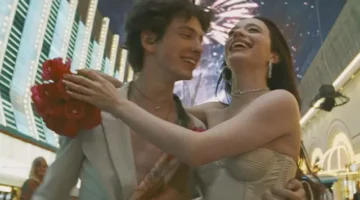Dom Hemingway
Jude Law sheds his Hollywood glamour and seems the one having the most fun in "Dom Hemingway," a new dark comedy by director Richard Shepard (Ugly Betty).
Law plays an egocentric and hardened British safecracker with some slightly Shakespearean saliva, Dom Hemingway. Dom has been incarcerated for twelve years over a bad deal. His only friend is Dickie (Richard E. Grant) a Michael Caine-ish cohort with a black leather hand.
Right from the get-go director Shepard pushes the envelope, having Hemingway getting oral sex in prison from a mean mister as he roars half-poetically about his penis.
Abruptly, Dom is released and tries to find criminal employment but no one wants a thing to do with him: he's maudlin sad and sour, a bit like Jack Sparrow soaked in 80 proof and absinthe.
Dom is a one-man orgy container. He swaggers. He spits. He chugs liquids potable and not so, out wolfing the Wolf of Wall Street.
He checks in with his old buddy, the ostentatious Fontaine (Demian Bichir) who plays his character like Gomez Addams, complete with a rifle and white suit.
Although Bichir's character is too comically drawn, this is Law's best scene whose raging tirade is alliterative and nothing short of something nastily dark, coarse and angelic. Dom makes an ass of himself, but you would be hard pressed to find a singular and iron-rich example as the one found here with such adept and unrelenting staccato.
Dom makes a mine of marvels from his speech of offense and manure. Such talk would put Trey Parker in the land of truffles.
After a terribly gory accident, Dom tracks down a snooty and glib rival (Jumayn Hunter) who holds a grudge. The rival, Lestor, gives him a safe-cracking test that is almost certainly rigged from the first second.
He has no choice.
The best parts of "Dom Hemingway" give Law free reign to go wild in a feral, rangy way possessing a pendulous spontaneity. Jude Law is a human pinwheel and great fun to watch.
The film loses its freedom a bit though, when the story attempts to turn to drama rather than an iconoclastic character study with the introduction of Dom's daughter (Emilia Clarke) and his grandson (Jordan Nash). Such scenes of want and connection strike a conventional tone in contrast to what otherwise is so refreshingly zany and unapologetically sincere in its high volume.
One nice touch occurs when Dom enters a elite restaurant and sees Poulina, his own scarlet-nailed thief. What follows is perfectly snake-like and sneaky—a satisfying "just desserts".
Although the drama combines a little too lightly making the whole of "Dom Hemingway" more of a sketch than a full film, the crackling and crawling spirit of Jude Law is in terrific form here.
Regardless of some well-expected proceedings, Dom's dirty and spite-filled invective, at once elegant and execrable, is a sleight of tongue impossible to resist.
Finding Vivian Maier
In 2007, one John Maloof, a young man in solid black glasses needed photographic work on Chicago's Portage Park. He bid on a box of negatives priced about four hundred dollars at auction. The box belonged to Vivian Maier. Maloof found nothing of use for his particular project and stashed the work in his closet, almost forgotten.
Six months later, Maloof discovered something: hundreds of images that describe urban life as if by sorcery from a dark lantern, chiefly in black and white. Here was Gotham City: kids crying, homeless walking bagless and bereft, aged people looking like forgotten warriors or lost Mafioso, or just everyday walkers staring down the camera.
Maloof googled "Vivian Maier" but his search only delivered a white screen in response.
Then he found an address. He located the phone number of a man who knew Maier as his childhood nanny. Maloof also contacted MoMA but they were not interested, citing a lack of storage.
As a last resort, Maloof posted the photographs on the net in an effort to solve at least part of the mystery and spur interest.
It worked.
"Finding Vivian Maier", a documentary by Maloof himself and Charlie Siskel is about this quest to find answers as much as it is about the striking work that the artist has left behind.
Maier was a guardian for children but no Mary Poppins was she. Although Maier could be boundlessly entertaining taking the kids on candy runs, she sometimes beat her charges, having a temper and problems with anger. Despite this blackness, most of the families liked her although they became exasperated by her hoarding of all things especially newspapers.
Some families were forced to let her go.
Maier was a ghost, floating through both city and solitude. Her photographs speak of a quirky feast of all souls, (half of a carnival, and the rest, a haunt) with her images of dismembered mannequins coupled with spectral self portraits of the photographer: plain and poker faced—a big boned anonymous phantom visiting the earth, taking pictures.
Maier had the ability to intrude just enough and disappear.
Most recall her as a friend to children. She recorded and left and made audio tapes of young kids, her best subject.
When confronted, Maier often gave false names, affecting a French accent.
She invented herself as a kind of Highsmithic Vivian "Ripley" taking refuge in work that no one saw or was given permission to see.
The most palpable apprehension in "Finding Vivian Maier" comes from the interviews of her clients and charges, now adult. Some liked and cared for her, some called her "mean", "witchy" and "abusive" but all were in awe of her as she invariably made an impression.
Talk show host Phil Donahue remembers Maier photographing his trash after her housekeeping duties, and a girl remembers going with Maier to a stockyard, witnessing the slaughter of sheep.
Several say that Vivian Maier was attacked as a younger person and this may have accounted for her obsessive hoarding and her unflinching eye.
She unsentimentally traversed the globe, specifically Egypt and France, with chests of negatives but few biographical footsteps.
Gradually, with little money, she took to a modest apartment and through a fall, became homeless, somewhat sardonically mirroring her work.
Despite her lamentable fate, Maier has left a impenetrable trove with imagery that rivals the work of crime photographer Weegee, the inimitable Diane Arbus and last but not least, the provocateur Sally Mann.
Write Ian at [email protected]
[livemarket market_name="KONK Life LiveMarket" limit=3 category=“” show_signup=0 show_more=0]





No Comment